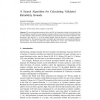AAAI
2012
12 years 9 months ago
2012
This paper concerns learning and prediction with probabilistic models where the domain sizes of latent variables have no a priori upper-bound. Current approaches represent prior d...
IACR
2011
13 years 6 months ago
2011
Given a lattice L with the i-th successive minimum λi, its i-th gap λi λ1 often provides useful information for analyzing the security of cryptographic schemes related to L. The...
CP
2011
Springer
13 years 7 months ago
2011
Springer
A depth-first search algorithm can be used to find optimal solutions of a Constraint Satisfaction Problem (CSP) with respect to a set of conditional preferences statements (e.g.,...
CEC
2011
IEEE
13 years 7 months ago
2011
IEEE
—We develop a stochastic local search algorithm for finding Pareto points for multi-criteria optimization problems. The algorithm alternates between different single-criterium o...
117
click to vote
ATVA
2011
Springer
13 years 7 months ago
2011
Springer
Even though the well-known nested-depth first search algorithm for LTL model checking provides good performance, it cannot benefit from the recent advent of multi-core computers....
EMNLP
2009
14 years 4 months ago
2009
We present an inexact search algorithm for the problem of predicting a two-layered dependency graph. The algorithm is based on a k-best version of the standard cubictime search al...
RC
2007
14 years 6 months ago
2007
The search algorithm presented allows the CDF of a dependent variable to be bounded with 100%confidence,andallowsforaguaranteedevaluationof theerror involved.Thesereliabilitybound...
CG
2002
Springer
14 years 7 months ago
2002
Springer
Abstract. The paper introduces a new proof-number (PN) search algorithm, called PDS-PN. It is a two-level search, which performs at the first level a depth-first Proof-number and D...
AI
2002
Springer
14 years 7 months ago
2002
Springer
We describe a novel parallel randomized search algorithm for two-player games. The algorithm is a randomized version of Korf and Chickering's best-first search. Randomization...
TWC
2008
14 years 7 months ago
2008
A box-constrained integer least squares problem (BILS) arises from several wireless communications applications. Solving a BILS problem usually has two stages: reduction (or prepro...


